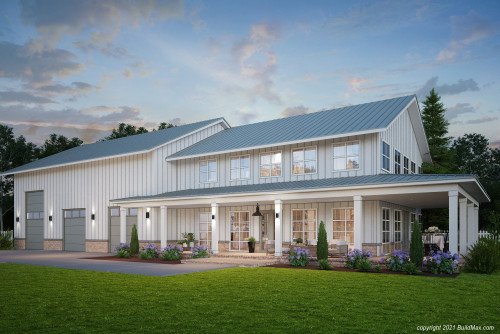Barndominium Repair Specialists: Specialist Aid for Your Barndominium
Barndominium Repair Specialists: Specialist Aid for Your Barndominium
Blog Article
Barndominiums Vs. Typical Residences: a Thorough Contrast of Way Of Life and Performance
The decision in between barndominiums and traditional homes incorporates various variables, including way of living preferences and practical requirements. Barndominiums are defined by their open layouts and versatility, often appealing to those that focus on common living and convenience.
Summary of Barndominiums
Barndominiums, a novel housing trend acquiring popularity across various regions, blend the rustic charm of barn-style architecture with the functionality of modern home. These unique frameworks typically are composed of a steel or timber structure, integrating open floor plans and high ceilings with energy-efficient features. Often positioned on large country properties, barndominiums supply home owners the possibility to take pleasure in a peaceful lifestyle while providing enough room for different activities.
The versatility of barndominiums expands beyond their aesthetic allure; they can offer as both living quarters and practical rooms for leisure activities, workshops, or perhaps small organizations. Their flexible design permits simple personalization, accommodating varied family demands and choices. Many proprietors appreciate the reduced maintenance requirements connected with metal siding and roof covering, contributing to long-term sturdiness.

Attributes of Typical Homes
Emphasizing ageless style and convenience, typical homes are characterized by their distinct architectural styles, which commonly mirror historic impacts and regional aesthetic appeals. Typical attributes consist of balanced exteriors, gabled roofs, and an emphasis on craftsmanship, resulting in a warm and inviting environment.
Standard homes commonly include components such as crown molding, wainscoting, and wood floor covering, boosting their timeless charm. They normally include several spaces with defined functions, promoting family interaction while permitting personal privacy. click here. The format usually consists of official living and eating locations, which are helpful to enjoyable guests and hosting household celebrations
Exterior materials such as block, wood, or stone are often used, contributing to sturdiness and a sense of durability. Barndominium repair. Furthermore, lots of traditional homes are created with front verandas or stoops, promoting a feeling of area and link with the neighborhood
Landscape design plays a considerable duty in conventional home layout, with properly maintained yards and pathways that enhance curb allure - visit site. On the whole, typical homes personify a feeling of fond memories and stability, attracting those who value heritage and a more organized living setting
Expense Comparison
Generally, a cost contrast in between barndominiums and conventional homes reveals significant distinctions in building and construction costs and overall financial investment. Barndominiums, usually built from metal or steel frames, commonly sustain lower product and labor expenses than conventional homes built from timber and browse around this site brick. The streamlined style of barndominiums can translate to lowered building times, even more lowering labor expenses and expediting tenancy.
Generally, the cost per square foot for a barndominium varies from $100 to $150, while traditional homes can differ widely, typically dropping between $150 and $300 per square foot, relying on location, products, and design intricacy. This cost variation makes barndominiums an attractive alternative for budget-conscious buyers looking for larger home without sacrificing high quality.
Additionally, barndominiums may lead to long-lasting financial savings with reduced maintenance expenses, power effectiveness, and insurance policy rates. Their long lasting construction materials usually need much less upkeep gradually compared to conventional homes. It is crucial to consider that while preliminary expenses might be reduced for barndominiums, the last investment will likewise depend on private modification and wanted amenities, which can influence the general cost in both real estate kinds.
Way Of Living and Space Considerations
When considering way of life and area, barndominiums use an one-of-a-kind adaptability that interest a variety of property owners. These hybrid structures integrate domestic dealing with practical area, typically featuring open floor plans that can be adapted to suit individual needs. This adaptability is specifically useful for family members or people looking for an individualized living atmosphere, permitting diverse uses such as home workplaces, workshops, or entertainment areas.

Moreover, the aesthetic allure of barndominiums can satisfy both rustic and modern tastes, making them a flexible choice for different design preferences (Barndominium repair). Eventually, the selection between a barndominium and a typical home typically pivots on how well each alternative aligns with the house owner's way of living goals and spatial needs, highlighting the importance of thinking about individual priorities in the decision-making procedure
Ecological Impact and Sustainability
The ecological influence and sustainability of barndominiums present compelling benefits contrasted to traditional homes. Primarily constructed from steel and other durable materials, barndominiums are commonly developed utilizing recycled sources, minimizing the need for brand-new products and reducing waste. Their style generally emphasizes open rooms, which can bring about lower energy usage for heating & cooling contrasted to conventional homes with even more fractional formats.
Moreover, barndominiums can incorporate sustainable functions such as solar panels, rainwater harvesting systems, and advanced insulation strategies, boosting their energy effectiveness. The versatility of their layout enables homeowners to integrate these modern technologies more seamlessly than in many conventional homes, which may require extensive retrofitting.
Additionally, barndominiums frequently require fewer sources for building and construction as a result of their easier, a lot more effective designs. This not only decreases the carbon impact related to building but additionally adds to a much more sustainable lifestyle. In contrast, typical homes may involve higher degrees of energy expenditure and source utilize throughout their lifecycle, from building to maintenance. On the whole, barndominiums stand for a forward-thinking method to lasting living, straightening with contemporary environmental top priorities.
Final Thought
In summary, the selection between barndominiums and standard homes hinges on private lifestyle preferences and useful requirements. Barndominiums, with their open designs and lasting materials, provide to those seeking flexibility and public living.
Report this page